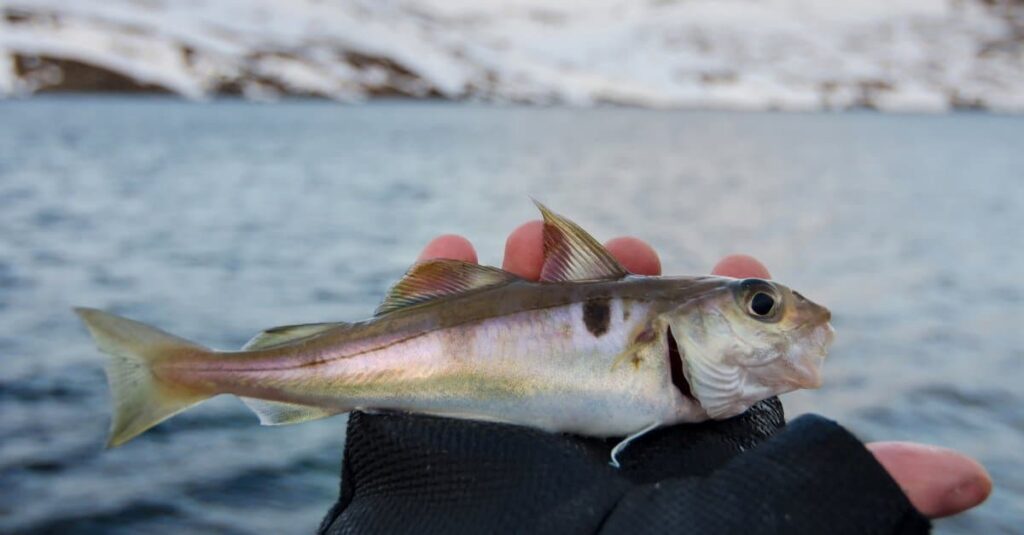How do fish survive the winter? If you’re like the vast majority of people, you’ve probably never given the question much thought. But the truth is that most fish in the wild face seasonal temperature changes that seriously challenge their ability to survive. Because most species are cold-blooded, they can’t regulate their temperature. So how on earth do they do it? Read on to discover five amazing ways fish adapt to the cold!
Do Fish Get Cold?

The haddock is an example of a famous coldwater fish species.
©Piotr Wawrzyniuk/Shutterstock.com
Fish get cold quite easily, although their preferred temperatures vary considerably from species to species. Coldwater fish species include the following:
Warmwater fish species include the following:
How Do Fish Survive the Winter?

Common ways fish adapt to cold temperatures include going into torpor and migrating.
©iStock.com/scubaluna
Fish use several amazing techniques to survive brutally cold temperatures. Being mostly cold-blooded (which means they cannot warm themselves up), they have to find ways of keeping themselves alive despite their surroundings.
1. Go Into Torpor
One way fish survive the winter is by going into torpor. Torpor is similar to hibernation, though there’s a distinct difference between the two states. Hibernation involves an animal lowering its metabolic rate, breathing rate, heart rate, and body temperature for extended periods. The result is a state resembling prolonged deep sleep. Torpor involves the same basic techniques but is not as deep or as long. Torpor usually only lasts a few hours at a time and may take place daily.
Fish do not truly hibernate but rather go into torpor to conserve energy. They usually do this in schools for added safety and warmth. Despite their sluggish state, they can still rouse themselves if they sense danger or a passing meal. This makes it possible for anglers to catch fish in the drowsy winter months.
2. Head for Deeper Water
One of water’s quirky traits is that it freezes from the top down instead of the bottom up. Most liquids become denser and therefore heavier as they get colder, which means the coldest portions sink to the bottom. But when the water cools below 39°F, it expands, which makes it lighter and causes it to float to the top. Therefore, the warmer water stays on the bottom.
If not for this unusual behavior, fish would get gradually pushed to the surface by freezing water and die on top of a massive chunk of ice. Because warm water sinks below cold water after it reaches a certain temperature, fish can head for the depths and stay warmer than they would near the surface.
3. Bury Themselves in Mud
To insulate themselves from the cold water, some fish species bury themselves in mud. They then go into torpor to maximize the effect. Koi and gobies are especially fond of this technique. The mud also helps hide them from passing predators who might otherwise take advantage of their sluggish state.
4. Warm Their Blood
As noted above, most fish species are cold-blooded, but there are a few notable exceptions. The opah or moonfish (Lampris guttatus) is the only known fully warm-blooded fish species in the world. Researchers at the NOAA Southwest Fisheries Science Center first brought this species’ remarkable distinction into the public eye in 2015. It circulates warm blood throughout its body to enable it to survive in cold water up to 1,300 feet below the surface.
In addition to the opah, the bluefin tuna is also able to warm its blood to a degree. However, this species is not fully warm-blooded despite this adaptation. It has simply developed the ability to retain much of the heat it produces instead of losing all or most of it through its gills.
5. Migrate
If all else fails, some fish species can migrate once the water temperature starts to drop. These migrations can take place over hundreds or even thousands of miles. However, not all species are capable of making such a journey and must rely on the other adaptations listed above. Some fish that migrate based on temperature include herring, tuna, and great white sharks.
Fish in Captivity

It’s critical to know your pet fish’s ideal temperature range and check the tank thermometer frequently.
©iStock.com/Kanawa_Studio
Fish in captivity rarely need to worry about climate change as they live in a regulated environment. If you own fish, be sure to understand their ideal water temperature and check it regularly for anomalies. Although some species are more tolerant than others, most fish are highly sensitive to temperature changes and may not survive a serious disruption despite their adaptations.
Summary Table: How Do Fish Survive the Winter?
| Number | Technique |
|---|---|
| 1 | Go into torpor |
| 2 | Head for deeper water |
| 3 | Bury themselves in mud |
| 4 | Warm their blood |
| 5 | Migrate |
The photo featured at the top of this post is © iStock.com/den-belitsky
Thank you for reading! Have some feedback for us? Contact the AZ Animals editorial team.






